Managing Across Cultures: BUS5001 Report on Cultural Dimensions
VerifiedAdded on 2023/06/11
|15
|5024
|399
Report
AI Summary
This report examines managing across cultures in international business, emphasizing the importance of understanding national culture. It highlights cultural differences in leadership, motivation, communication, negotiation, and decision-making. The report discusses Hofstede's model of cultural diversity, Kluckhohn and Strodtbeck's cultural dimensions, and Trompenaars and Hampden-Turner's theory on national culture differences. It analyzes power distance, individualism vs. collectivism, uncertainty avoidance, masculinity vs. femininity, and long-term orientation. The report also contrasts and compares these theories, concluding with the significance of cultural understanding in international management.

MANAGING ACROSS
CULTURES
CULTURES
Paraphrase This Document
Need a fresh take? Get an instant paraphrase of this document with our AI Paraphraser
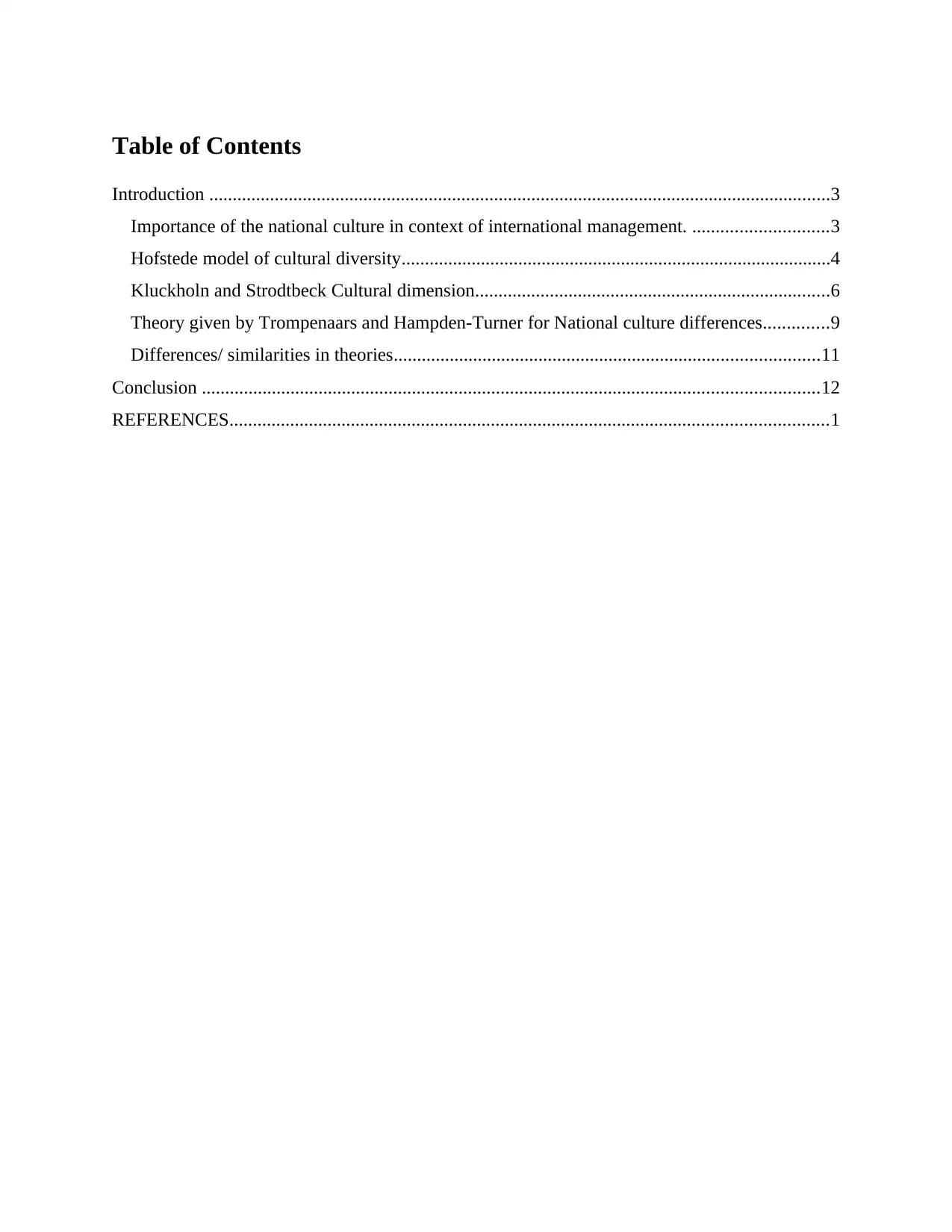
Table of Contents
Introduction .....................................................................................................................................3
Importance of the national culture in context of international management. .............................3
Hofstede model of cultural diversity............................................................................................4
Kluckholn and Strodtbeck Cultural dimension............................................................................6
Theory given by Trompenaars and Hampden-Turner for National culture differences..............9
Differences/ similarities in theories...........................................................................................11
Conclusion ....................................................................................................................................12
REFERENCES................................................................................................................................1
Introduction .....................................................................................................................................3
Importance of the national culture in context of international management. .............................3
Hofstede model of cultural diversity............................................................................................4
Kluckholn and Strodtbeck Cultural dimension............................................................................6
Theory given by Trompenaars and Hampden-Turner for National culture differences..............9
Differences/ similarities in theories...........................................................................................11
Conclusion ....................................................................................................................................12
REFERENCES................................................................................................................................1

Introduction
Cultural management refers to the process of managing the culture of the organisation by the
leader or the members of the organization. The leader of the company maintain the culture of the
organization by consisting of the values, belief and norms. With the assistance of the
organizational culture the leader of the organisation encourage the employees to increase their
engagement in the production of the company. Due to that the company is able to increase the
scale of profitability and productivity of the company in effective as well as efficient manner
(Kristjánsdóttir, Guðlaugsson, Guðmundsdóttir and Aðalsteinsson,2017) . Moreover, with the
help of the cultural management the organisation is able to bring the innovation, enhance the
skills and knowledge of the individual person in appropriate manner.
The present report is on the access of the culture in the organisation. The report will examine the
importance of understanding the national culture in context of international management which
essential in the domestic as well as international marketplace. Furthermore, the study will
highlight the culture differences in relation to leadership, motivation, communication,
negotiation and decision making. In context to that the report will shade a light on Hofstede's
models and other key cross theories. Apart from that the document reflect the differences and the
similarities in the mention theories in adequate manner.
Importance of the national culture in context of international management.
The national culture is very important top understand by the multinational organization in orders
to acquire the success in domestic as well as international marketplace. With the assistance of the
culture, international business will able to provide the adequate norms, values, belief, language,
behaviour of the individual person that satisfy the large numbers of the customers and the
employees of the organization from different marketplace. With the assistance of the national
culture in the international organization allow the manger or the employees of the company to
address the issues which the customers are facing at the time of experiencing the services of the
company. Basically in the international management the national culture of the host country play
huge role in managing the function of the firm (Tenzer, Terjesen and Harzing, 2017) . With the
assistance of the national culture the organisation is be to increase the sales by satisfying the
different customers. Due to that the organisation attract large numbers of the customers and
increase the awareness among the people. If the culture of the organisation is not according to
Cultural management refers to the process of managing the culture of the organisation by the
leader or the members of the organization. The leader of the company maintain the culture of the
organization by consisting of the values, belief and norms. With the assistance of the
organizational culture the leader of the organisation encourage the employees to increase their
engagement in the production of the company. Due to that the company is able to increase the
scale of profitability and productivity of the company in effective as well as efficient manner
(Kristjánsdóttir, Guðlaugsson, Guðmundsdóttir and Aðalsteinsson,2017) . Moreover, with the
help of the cultural management the organisation is able to bring the innovation, enhance the
skills and knowledge of the individual person in appropriate manner.
The present report is on the access of the culture in the organisation. The report will examine the
importance of understanding the national culture in context of international management which
essential in the domestic as well as international marketplace. Furthermore, the study will
highlight the culture differences in relation to leadership, motivation, communication,
negotiation and decision making. In context to that the report will shade a light on Hofstede's
models and other key cross theories. Apart from that the document reflect the differences and the
similarities in the mention theories in adequate manner.
Importance of the national culture in context of international management.
The national culture is very important top understand by the multinational organization in orders
to acquire the success in domestic as well as international marketplace. With the assistance of the
culture, international business will able to provide the adequate norms, values, belief, language,
behaviour of the individual person that satisfy the large numbers of the customers and the
employees of the organization from different marketplace. With the assistance of the national
culture in the international organization allow the manger or the employees of the company to
address the issues which the customers are facing at the time of experiencing the services of the
company. Basically in the international management the national culture of the host country play
huge role in managing the function of the firm (Tenzer, Terjesen and Harzing, 2017) . With the
assistance of the national culture the organisation is be to increase the sales by satisfying the
different customers. Due to that the organisation attract large numbers of the customers and
increase the awareness among the people. If the culture of the organisation is not according to
⊘ This is a preview!⊘
Do you want full access?
Subscribe today to unlock all pages.

Trusted by 1+ million students worldwide
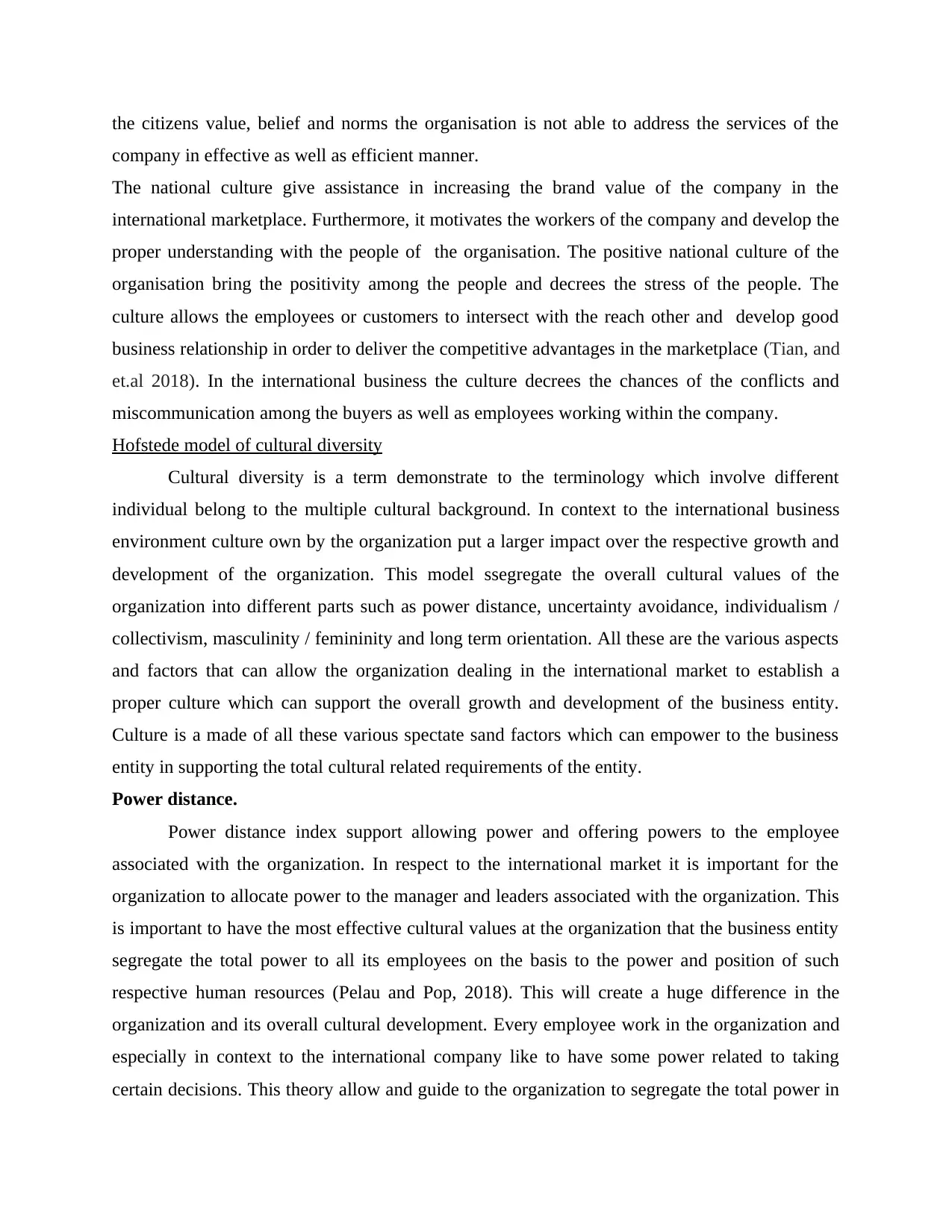
the citizens value, belief and norms the organisation is not able to address the services of the
company in effective as well as efficient manner.
The national culture give assistance in increasing the brand value of the company in the
international marketplace. Furthermore, it motivates the workers of the company and develop the
proper understanding with the people of the organisation. The positive national culture of the
organisation bring the positivity among the people and decrees the stress of the people. The
culture allows the employees or customers to intersect with the reach other and develop good
business relationship in order to deliver the competitive advantages in the marketplace (Tian, and
et.al 2018). In the international business the culture decrees the chances of the conflicts and
miscommunication among the buyers as well as employees working within the company.
Hofstede model of cultural diversity
Cultural diversity is a term demonstrate to the terminology which involve different
individual belong to the multiple cultural background. In context to the international business
environment culture own by the organization put a larger impact over the respective growth and
development of the organization. This model ssegregate the overall cultural values of the
organization into different parts such as power distance, uncertainty avoidance, individualism /
collectivism, masculinity / femininity and long term orientation. All these are the various aspects
and factors that can allow the organization dealing in the international market to establish a
proper culture which can support the overall growth and development of the business entity.
Culture is a made of all these various spectate sand factors which can empower to the business
entity in supporting the total cultural related requirements of the entity.
Power distance.
Power distance index support allowing power and offering powers to the employee
associated with the organization. In respect to the international market it is important for the
organization to allocate power to the manager and leaders associated with the organization. This
is important to have the most effective cultural values at the organization that the business entity
segregate the total power to all its employees on the basis to the power and position of such
respective human resources (Pelau and Pop, 2018). This will create a huge difference in the
organization and its overall cultural development. Every employee work in the organization and
especially in context to the international company like to have some power related to taking
certain decisions. This theory allow and guide to the organization to segregate the total power in
company in effective as well as efficient manner.
The national culture give assistance in increasing the brand value of the company in the
international marketplace. Furthermore, it motivates the workers of the company and develop the
proper understanding with the people of the organisation. The positive national culture of the
organisation bring the positivity among the people and decrees the stress of the people. The
culture allows the employees or customers to intersect with the reach other and develop good
business relationship in order to deliver the competitive advantages in the marketplace (Tian, and
et.al 2018). In the international business the culture decrees the chances of the conflicts and
miscommunication among the buyers as well as employees working within the company.
Hofstede model of cultural diversity
Cultural diversity is a term demonstrate to the terminology which involve different
individual belong to the multiple cultural background. In context to the international business
environment culture own by the organization put a larger impact over the respective growth and
development of the organization. This model ssegregate the overall cultural values of the
organization into different parts such as power distance, uncertainty avoidance, individualism /
collectivism, masculinity / femininity and long term orientation. All these are the various aspects
and factors that can allow the organization dealing in the international market to establish a
proper culture which can support the overall growth and development of the business entity.
Culture is a made of all these various spectate sand factors which can empower to the business
entity in supporting the total cultural related requirements of the entity.
Power distance.
Power distance index support allowing power and offering powers to the employee
associated with the organization. In respect to the international market it is important for the
organization to allocate power to the manager and leaders associated with the organization. This
is important to have the most effective cultural values at the organization that the business entity
segregate the total power to all its employees on the basis to the power and position of such
respective human resources (Pelau and Pop, 2018). This will create a huge difference in the
organization and its overall cultural development. Every employee work in the organization and
especially in context to the international company like to have some power related to taking
certain decisions. This theory allow and guide to the organization to segregate the total power in
Paraphrase This Document
Need a fresh take? Get an instant paraphrase of this document with our AI Paraphraser
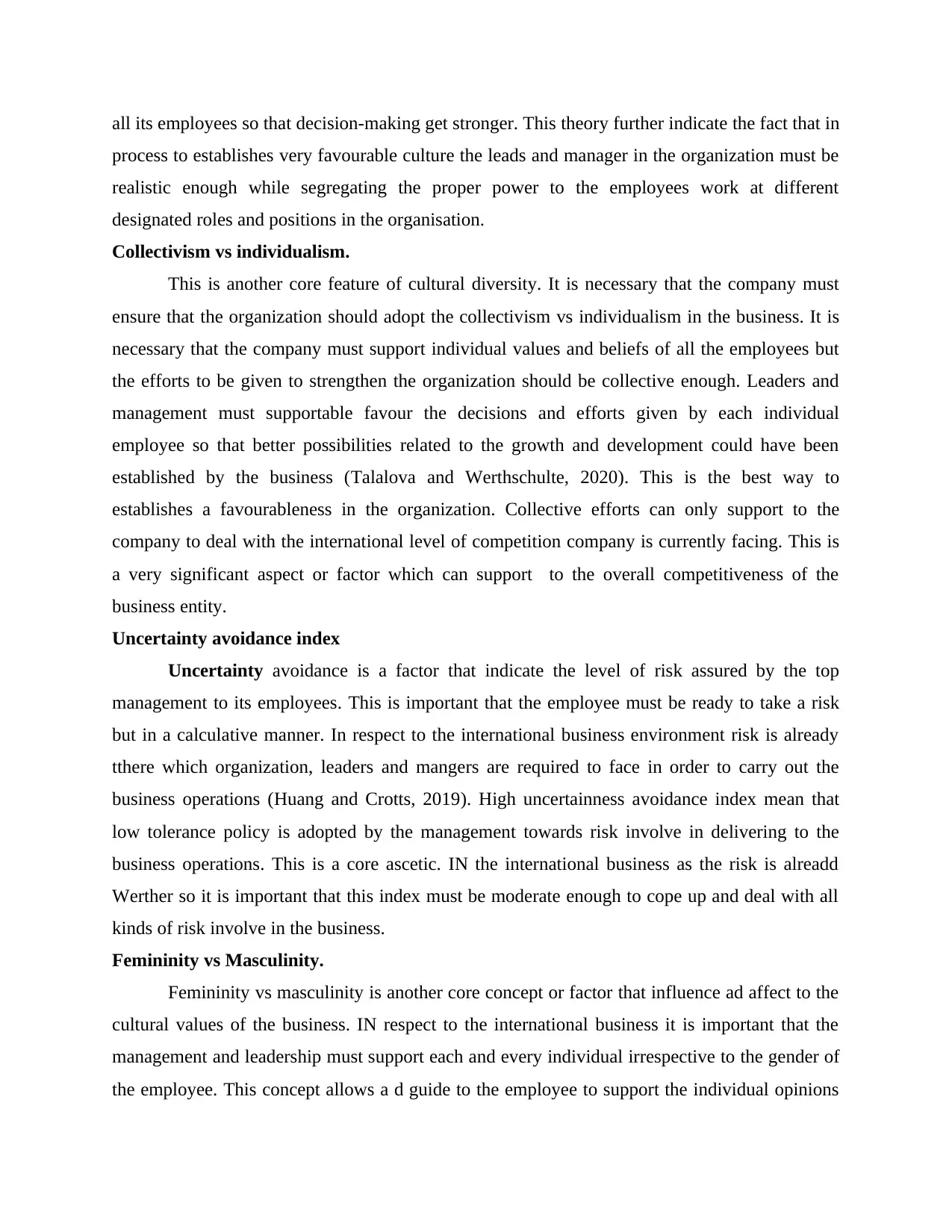
all its employees so that decision-making get stronger. This theory further indicate the fact that in
process to establishes very favourable culture the leads and manager in the organization must be
realistic enough while segregating the proper power to the employees work at different
designated roles and positions in the organisation.
Collectivism vs individualism.
This is another core feature of cultural diversity. It is necessary that the company must
ensure that the organization should adopt the collectivism vs individualism in the business. It is
necessary that the company must support individual values and beliefs of all the employees but
the efforts to be given to strengthen the organization should be collective enough. Leaders and
management must supportable favour the decisions and efforts given by each individual
employee so that better possibilities related to the growth and development could have been
established by the business (Talalova and Werthschulte, 2020). This is the best way to
establishes a favourableness in the organization. Collective efforts can only support to the
company to deal with the international level of competition company is currently facing. This is
a very significant aspect or factor which can support to the overall competitiveness of the
business entity.
Uncertainty avoidance index
Uncertainty avoidance is a factor that indicate the level of risk assured by the top
management to its employees. This is important that the employee must be ready to take a risk
but in a calculative manner. In respect to the international business environment risk is already
tthere which organization, leaders and mangers are required to face in order to carry out the
business operations (Huang and Crotts, 2019). High uncertainness avoidance index mean that
low tolerance policy is adopted by the management towards risk involve in delivering to the
business operations. This is a core ascetic. IN the international business as the risk is alreadd
Werther so it is important that this index must be moderate enough to cope up and deal with all
kinds of risk involve in the business.
Femininity vs Masculinity.
Femininity vs masculinity is another core concept or factor that influence ad affect to the
cultural values of the business. IN respect to the international business it is important that the
management and leadership must support each and every individual irrespective to the gender of
the employee. This concept allows a d guide to the employee to support the individual opinions
process to establishes very favourable culture the leads and manager in the organization must be
realistic enough while segregating the proper power to the employees work at different
designated roles and positions in the organisation.
Collectivism vs individualism.
This is another core feature of cultural diversity. It is necessary that the company must
ensure that the organization should adopt the collectivism vs individualism in the business. It is
necessary that the company must support individual values and beliefs of all the employees but
the efforts to be given to strengthen the organization should be collective enough. Leaders and
management must supportable favour the decisions and efforts given by each individual
employee so that better possibilities related to the growth and development could have been
established by the business (Talalova and Werthschulte, 2020). This is the best way to
establishes a favourableness in the organization. Collective efforts can only support to the
company to deal with the international level of competition company is currently facing. This is
a very significant aspect or factor which can support to the overall competitiveness of the
business entity.
Uncertainty avoidance index
Uncertainty avoidance is a factor that indicate the level of risk assured by the top
management to its employees. This is important that the employee must be ready to take a risk
but in a calculative manner. In respect to the international business environment risk is already
tthere which organization, leaders and mangers are required to face in order to carry out the
business operations (Huang and Crotts, 2019). High uncertainness avoidance index mean that
low tolerance policy is adopted by the management towards risk involve in delivering to the
business operations. This is a core ascetic. IN the international business as the risk is alreadd
Werther so it is important that this index must be moderate enough to cope up and deal with all
kinds of risk involve in the business.
Femininity vs Masculinity.
Femininity vs masculinity is another core concept or factor that influence ad affect to the
cultural values of the business. IN respect to the international business it is important that the
management and leadership must support each and every individual irrespective to the gender of
the employee. This concept allows a d guide to the employee to support the individual opinions
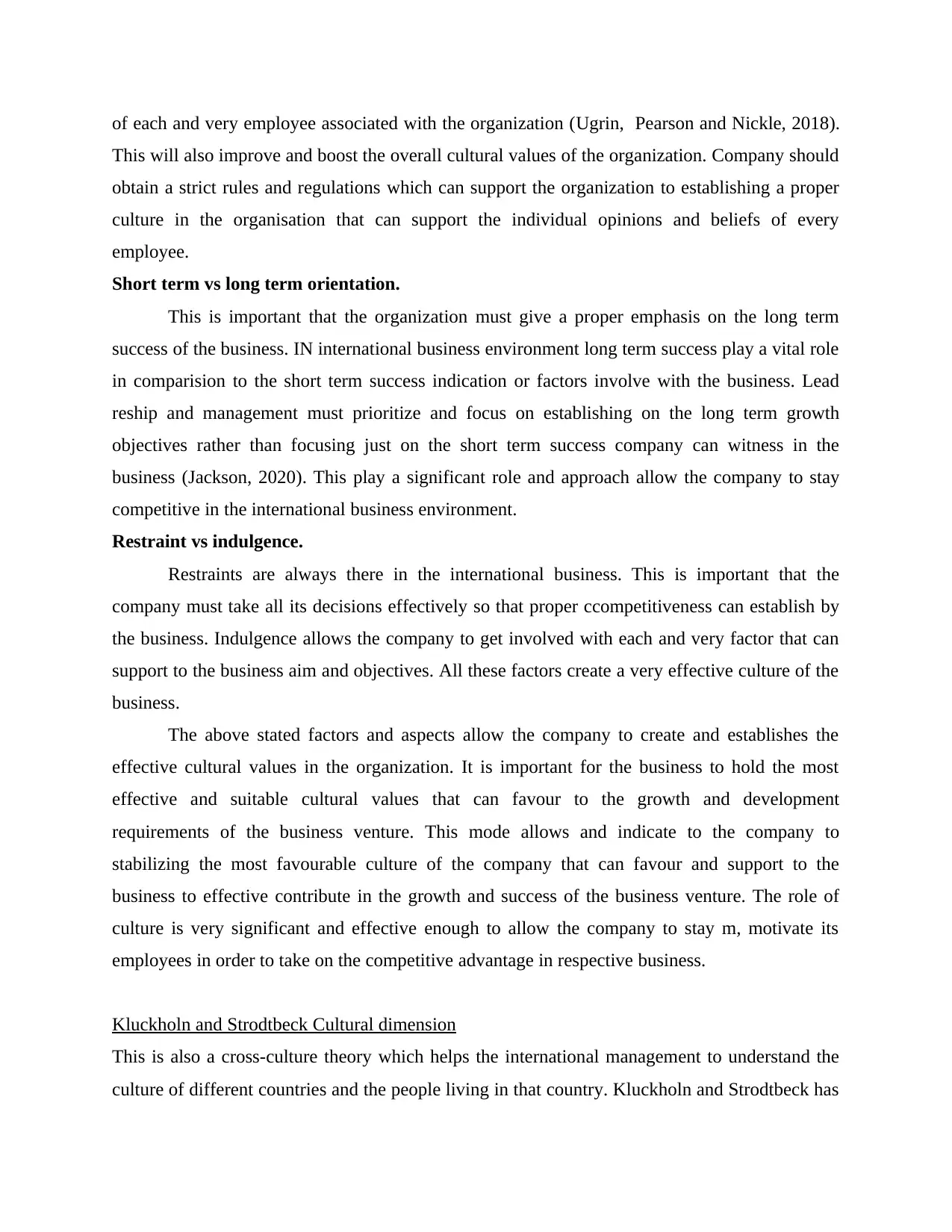
of each and very employee associated with the organization (Ugrin, Pearson and Nickle, 2018).
This will also improve and boost the overall cultural values of the organization. Company should
obtain a strict rules and regulations which can support the organization to establishing a proper
culture in the organisation that can support the individual opinions and beliefs of every
employee.
Short term vs long term orientation.
This is important that the organization must give a proper emphasis on the long term
success of the business. IN international business environment long term success play a vital role
in comparision to the short term success indication or factors involve with the business. Lead
reship and management must prioritize and focus on establishing on the long term growth
objectives rather than focusing just on the short term success company can witness in the
business (Jackson, 2020). This play a significant role and approach allow the company to stay
competitive in the international business environment.
Restraint vs indulgence.
Restraints are always there in the international business. This is important that the
company must take all its decisions effectively so that proper ccompetitiveness can establish by
the business. Indulgence allows the company to get involved with each and very factor that can
support to the business aim and objectives. All these factors create a very effective culture of the
business.
The above stated factors and aspects allow the company to create and establishes the
effective cultural values in the organization. It is important for the business to hold the most
effective and suitable cultural values that can favour to the growth and development
requirements of the business venture. This mode allows and indicate to the company to
stabilizing the most favourable culture of the company that can favour and support to the
business to effective contribute in the growth and success of the business venture. The role of
culture is very significant and effective enough to allow the company to stay m, motivate its
employees in order to take on the competitive advantage in respective business.
Kluckholn and Strodtbeck Cultural dimension
This is also a cross-culture theory which helps the international management to understand the
culture of different countries and the people living in that country. Kluckholn and Strodtbeck has
This will also improve and boost the overall cultural values of the organization. Company should
obtain a strict rules and regulations which can support the organization to establishing a proper
culture in the organisation that can support the individual opinions and beliefs of every
employee.
Short term vs long term orientation.
This is important that the organization must give a proper emphasis on the long term
success of the business. IN international business environment long term success play a vital role
in comparision to the short term success indication or factors involve with the business. Lead
reship and management must prioritize and focus on establishing on the long term growth
objectives rather than focusing just on the short term success company can witness in the
business (Jackson, 2020). This play a significant role and approach allow the company to stay
competitive in the international business environment.
Restraint vs indulgence.
Restraints are always there in the international business. This is important that the
company must take all its decisions effectively so that proper ccompetitiveness can establish by
the business. Indulgence allows the company to get involved with each and very factor that can
support to the business aim and objectives. All these factors create a very effective culture of the
business.
The above stated factors and aspects allow the company to create and establishes the
effective cultural values in the organization. It is important for the business to hold the most
effective and suitable cultural values that can favour to the growth and development
requirements of the business venture. This mode allows and indicate to the company to
stabilizing the most favourable culture of the company that can favour and support to the
business to effective contribute in the growth and success of the business venture. The role of
culture is very significant and effective enough to allow the company to stay m, motivate its
employees in order to take on the competitive advantage in respective business.
Kluckholn and Strodtbeck Cultural dimension
This is also a cross-culture theory which helps the international management to understand the
culture of different countries and the people living in that country. Kluckholn and Strodtbeck has
⊘ This is a preview!⊘
Do you want full access?
Subscribe today to unlock all pages.

Trusted by 1+ million students worldwide
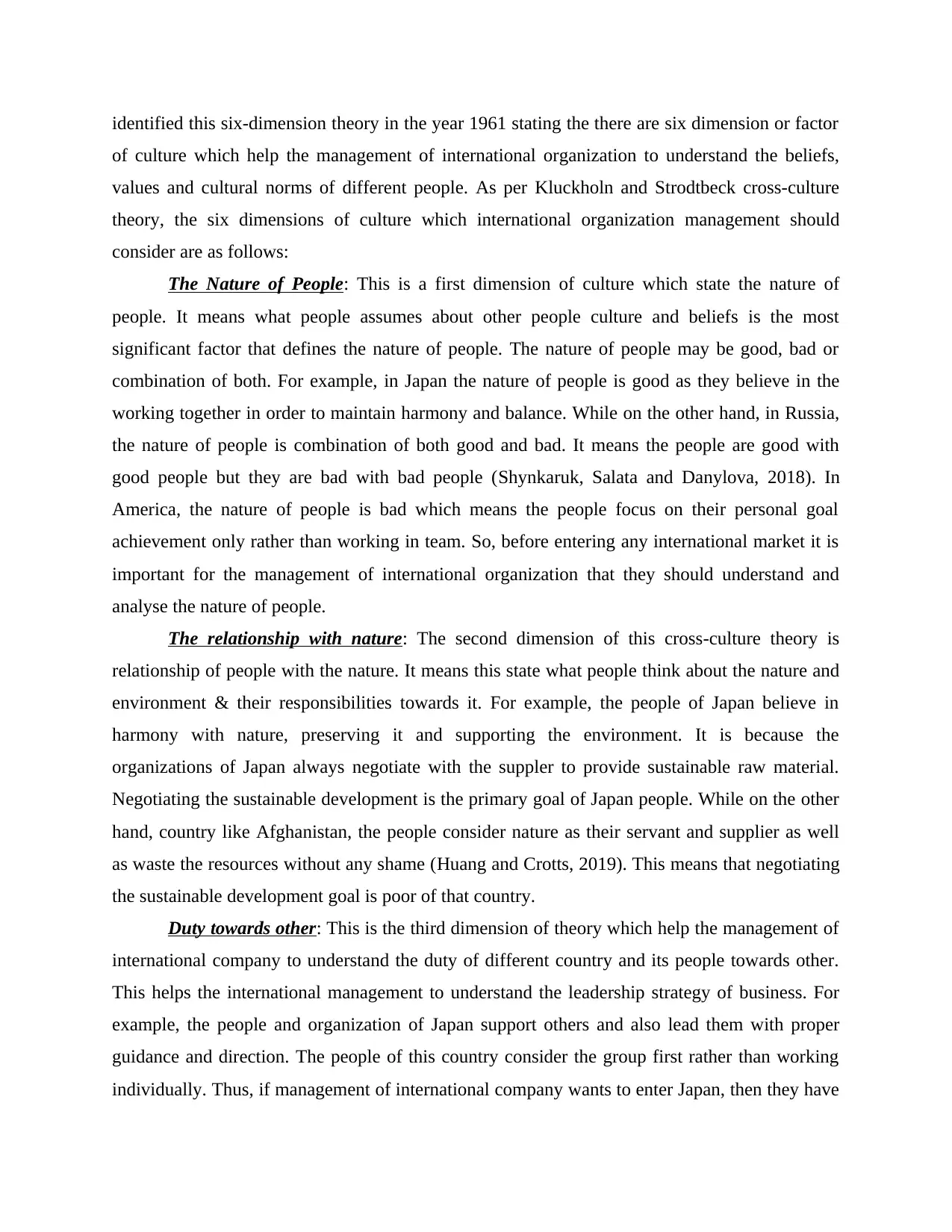
identified this six-dimension theory in the year 1961 stating the there are six dimension or factor
of culture which help the management of international organization to understand the beliefs,
values and cultural norms of different people. As per Kluckholn and Strodtbeck cross-culture
theory, the six dimensions of culture which international organization management should
consider are as follows:
The Nature of People: This is a first dimension of culture which state the nature of
people. It means what people assumes about other people culture and beliefs is the most
significant factor that defines the nature of people. The nature of people may be good, bad or
combination of both. For example, in Japan the nature of people is good as they believe in the
working together in order to maintain harmony and balance. While on the other hand, in Russia,
the nature of people is combination of both good and bad. It means the people are good with
good people but they are bad with bad people (Shynkaruk, Salata and Danylova, 2018). In
America, the nature of people is bad which means the people focus on their personal goal
achievement only rather than working in team. So, before entering any international market it is
important for the management of international organization that they should understand and
analyse the nature of people.
The relationship with nature: The second dimension of this cross-culture theory is
relationship of people with the nature. It means this state what people think about the nature and
environment & their responsibilities towards it. For example, the people of Japan believe in
harmony with nature, preserving it and supporting the environment. It is because the
organizations of Japan always negotiate with the suppler to provide sustainable raw material.
Negotiating the sustainable development is the primary goal of Japan people. While on the other
hand, country like Afghanistan, the people consider nature as their servant and supplier as well
as waste the resources without any shame (Huang and Crotts, 2019). This means that negotiating
the sustainable development goal is poor of that country.
Duty towards other: This is the third dimension of theory which help the management of
international company to understand the duty of different country and its people towards other.
This helps the international management to understand the leadership strategy of business. For
example, the people and organization of Japan support others and also lead them with proper
guidance and direction. The people of this country consider the group first rather than working
individually. Thus, if management of international company wants to enter Japan, then they have
of culture which help the management of international organization to understand the beliefs,
values and cultural norms of different people. As per Kluckholn and Strodtbeck cross-culture
theory, the six dimensions of culture which international organization management should
consider are as follows:
The Nature of People: This is a first dimension of culture which state the nature of
people. It means what people assumes about other people culture and beliefs is the most
significant factor that defines the nature of people. The nature of people may be good, bad or
combination of both. For example, in Japan the nature of people is good as they believe in the
working together in order to maintain harmony and balance. While on the other hand, in Russia,
the nature of people is combination of both good and bad. It means the people are good with
good people but they are bad with bad people (Shynkaruk, Salata and Danylova, 2018). In
America, the nature of people is bad which means the people focus on their personal goal
achievement only rather than working in team. So, before entering any international market it is
important for the management of international organization that they should understand and
analyse the nature of people.
The relationship with nature: The second dimension of this cross-culture theory is
relationship of people with the nature. It means this state what people think about the nature and
environment & their responsibilities towards it. For example, the people of Japan believe in
harmony with nature, preserving it and supporting the environment. It is because the
organizations of Japan always negotiate with the suppler to provide sustainable raw material.
Negotiating the sustainable development is the primary goal of Japan people. While on the other
hand, country like Afghanistan, the people consider nature as their servant and supplier as well
as waste the resources without any shame (Huang and Crotts, 2019). This means that negotiating
the sustainable development goal is poor of that country.
Duty towards other: This is the third dimension of theory which help the management of
international company to understand the duty of different country and its people towards other.
This helps the international management to understand the leadership strategy of business. For
example, the people and organization of Japan support others and also lead them with proper
guidance and direction. The people of this country consider the group first rather than working
individually. Thus, if management of international company wants to enter Japan, then they have
Paraphrase This Document
Need a fresh take? Get an instant paraphrase of this document with our AI Paraphraser
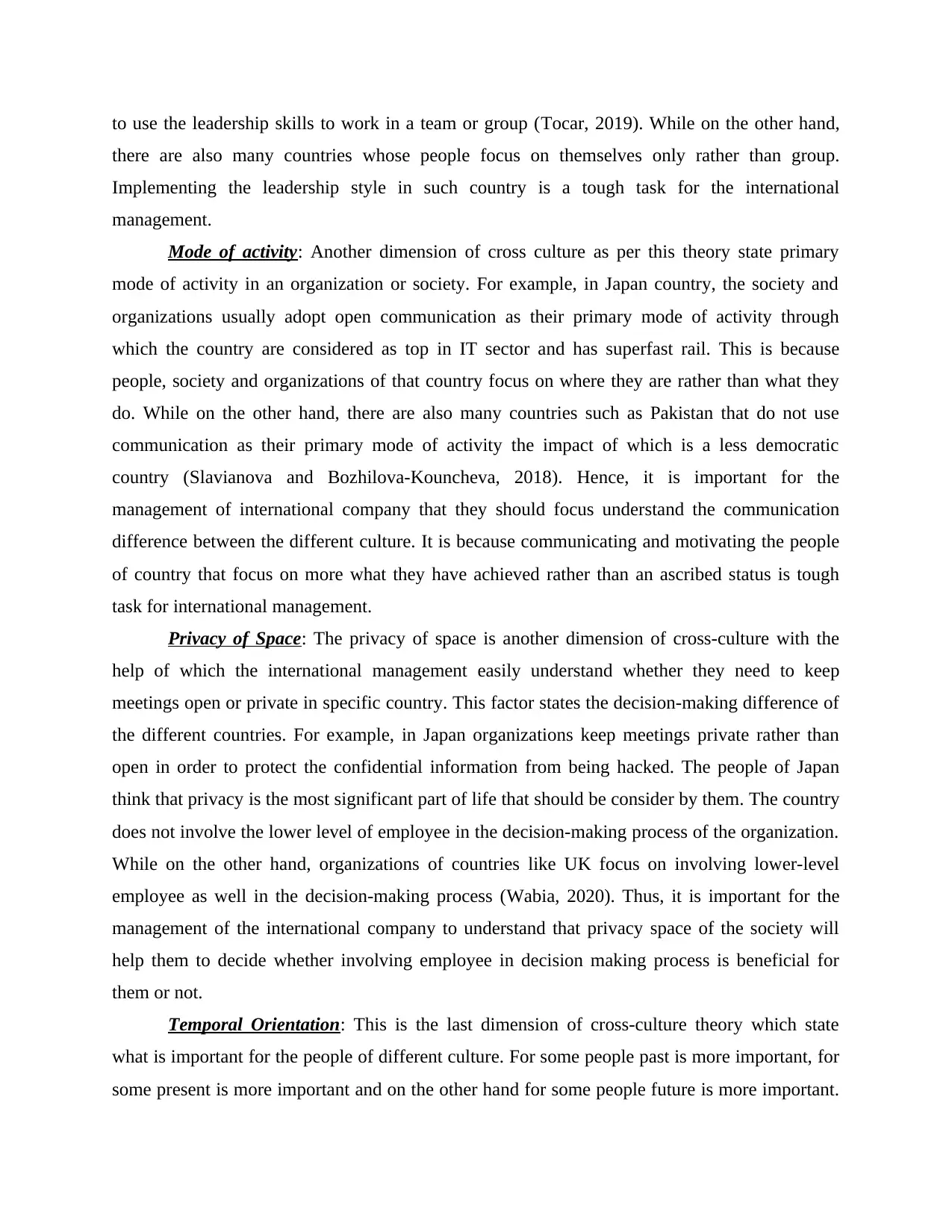
to use the leadership skills to work in a team or group (Tocar, 2019). While on the other hand,
there are also many countries whose people focus on themselves only rather than group.
Implementing the leadership style in such country is a tough task for the international
management.
Mode of activity: Another dimension of cross culture as per this theory state primary
mode of activity in an organization or society. For example, in Japan country, the society and
organizations usually adopt open communication as their primary mode of activity through
which the country are considered as top in IT sector and has superfast rail. This is because
people, society and organizations of that country focus on where they are rather than what they
do. While on the other hand, there are also many countries such as Pakistan that do not use
communication as their primary mode of activity the impact of which is a less democratic
country (Slavianova and Bozhilova-Kouncheva, 2018). Hence, it is important for the
management of international company that they should focus understand the communication
difference between the different culture. It is because communicating and motivating the people
of country that focus on more what they have achieved rather than an ascribed status is tough
task for international management.
Privacy of Space: The privacy of space is another dimension of cross-culture with the
help of which the international management easily understand whether they need to keep
meetings open or private in specific country. This factor states the decision-making difference of
the different countries. For example, in Japan organizations keep meetings private rather than
open in order to protect the confidential information from being hacked. The people of Japan
think that privacy is the most significant part of life that should be consider by them. The country
does not involve the lower level of employee in the decision-making process of the organization.
While on the other hand, organizations of countries like UK focus on involving lower-level
employee as well in the decision-making process (Wabia, 2020). Thus, it is important for the
management of the international company to understand that privacy space of the society will
help them to decide whether involving employee in decision making process is beneficial for
them or not.
Temporal Orientation: This is the last dimension of cross-culture theory which state
what is important for the people of different culture. For some people past is more important, for
some present is more important and on the other hand for some people future is more important.
there are also many countries whose people focus on themselves only rather than group.
Implementing the leadership style in such country is a tough task for the international
management.
Mode of activity: Another dimension of cross culture as per this theory state primary
mode of activity in an organization or society. For example, in Japan country, the society and
organizations usually adopt open communication as their primary mode of activity through
which the country are considered as top in IT sector and has superfast rail. This is because
people, society and organizations of that country focus on where they are rather than what they
do. While on the other hand, there are also many countries such as Pakistan that do not use
communication as their primary mode of activity the impact of which is a less democratic
country (Slavianova and Bozhilova-Kouncheva, 2018). Hence, it is important for the
management of international company that they should focus understand the communication
difference between the different culture. It is because communicating and motivating the people
of country that focus on more what they have achieved rather than an ascribed status is tough
task for international management.
Privacy of Space: The privacy of space is another dimension of cross-culture with the
help of which the international management easily understand whether they need to keep
meetings open or private in specific country. This factor states the decision-making difference of
the different countries. For example, in Japan organizations keep meetings private rather than
open in order to protect the confidential information from being hacked. The people of Japan
think that privacy is the most significant part of life that should be consider by them. The country
does not involve the lower level of employee in the decision-making process of the organization.
While on the other hand, organizations of countries like UK focus on involving lower-level
employee as well in the decision-making process (Wabia, 2020). Thus, it is important for the
management of the international company to understand that privacy space of the society will
help them to decide whether involving employee in decision making process is beneficial for
them or not.
Temporal Orientation: This is the last dimension of cross-culture theory which state
what is important for the people of different culture. For some people past is more important, for
some present is more important and on the other hand for some people future is more important.
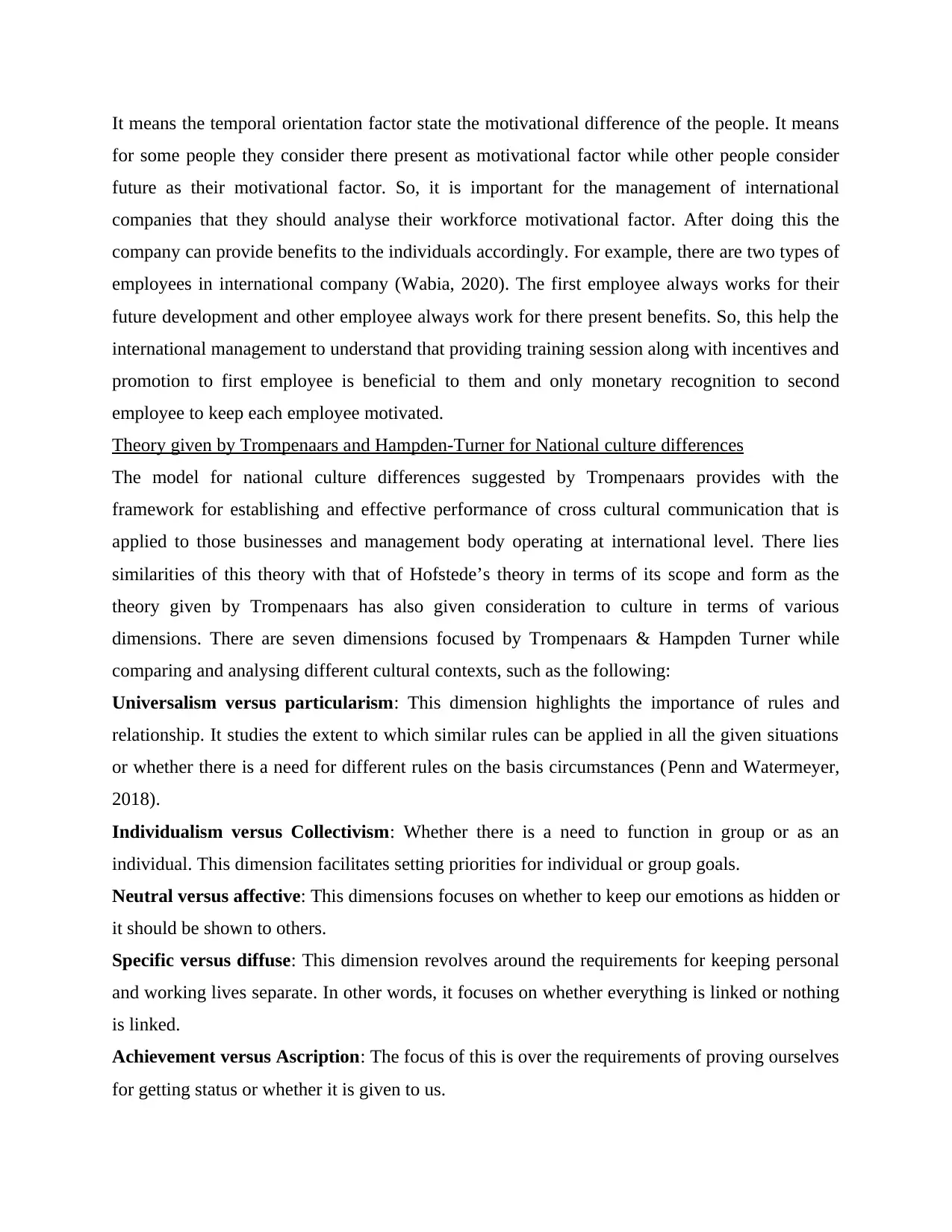
It means the temporal orientation factor state the motivational difference of the people. It means
for some people they consider there present as motivational factor while other people consider
future as their motivational factor. So, it is important for the management of international
companies that they should analyse their workforce motivational factor. After doing this the
company can provide benefits to the individuals accordingly. For example, there are two types of
employees in international company (Wabia, 2020). The first employee always works for their
future development and other employee always work for there present benefits. So, this help the
international management to understand that providing training session along with incentives and
promotion to first employee is beneficial to them and only monetary recognition to second
employee to keep each employee motivated.
Theory given by Trompenaars and Hampden-Turner for National culture differences
The model for national culture differences suggested by Trompenaars provides with the
framework for establishing and effective performance of cross cultural communication that is
applied to those businesses and management body operating at international level. There lies
similarities of this theory with that of Hofstede’s theory in terms of its scope and form as the
theory given by Trompenaars has also given consideration to culture in terms of various
dimensions. There are seven dimensions focused by Trompenaars & Hampden Turner while
comparing and analysing different cultural contexts, such as the following:
Universalism versus particularism: This dimension highlights the importance of rules and
relationship. It studies the extent to which similar rules can be applied in all the given situations
or whether there is a need for different rules on the basis circumstances (Penn and Watermeyer,
2018).
Individualism versus Collectivism: Whether there is a need to function in group or as an
individual. This dimension facilitates setting priorities for individual or group goals.
Neutral versus affective: This dimensions focuses on whether to keep our emotions as hidden or
it should be shown to others.
Specific versus diffuse: This dimension revolves around the requirements for keeping personal
and working lives separate. In other words, it focuses on whether everything is linked or nothing
is linked.
Achievement versus Ascription: The focus of this is over the requirements of proving ourselves
for getting status or whether it is given to us.
for some people they consider there present as motivational factor while other people consider
future as their motivational factor. So, it is important for the management of international
companies that they should analyse their workforce motivational factor. After doing this the
company can provide benefits to the individuals accordingly. For example, there are two types of
employees in international company (Wabia, 2020). The first employee always works for their
future development and other employee always work for there present benefits. So, this help the
international management to understand that providing training session along with incentives and
promotion to first employee is beneficial to them and only monetary recognition to second
employee to keep each employee motivated.
Theory given by Trompenaars and Hampden-Turner for National culture differences
The model for national culture differences suggested by Trompenaars provides with the
framework for establishing and effective performance of cross cultural communication that is
applied to those businesses and management body operating at international level. There lies
similarities of this theory with that of Hofstede’s theory in terms of its scope and form as the
theory given by Trompenaars has also given consideration to culture in terms of various
dimensions. There are seven dimensions focused by Trompenaars & Hampden Turner while
comparing and analysing different cultural contexts, such as the following:
Universalism versus particularism: This dimension highlights the importance of rules and
relationship. It studies the extent to which similar rules can be applied in all the given situations
or whether there is a need for different rules on the basis circumstances (Penn and Watermeyer,
2018).
Individualism versus Collectivism: Whether there is a need to function in group or as an
individual. This dimension facilitates setting priorities for individual or group goals.
Neutral versus affective: This dimensions focuses on whether to keep our emotions as hidden or
it should be shown to others.
Specific versus diffuse: This dimension revolves around the requirements for keeping personal
and working lives separate. In other words, it focuses on whether everything is linked or nothing
is linked.
Achievement versus Ascription: The focus of this is over the requirements of proving ourselves
for getting status or whether it is given to us.
⊘ This is a preview!⊘
Do you want full access?
Subscribe today to unlock all pages.

Trusted by 1+ million students worldwide

Sequential versus synchronic: The emphasis given here is on the requirement of close
management of time in the event of when it is finitely available or using the time in flexible
manner in order to juggle different events. This helps in deciding whether things need to be done
one by one or several things are required to be done at once only.
Inner directed versus Outer directed: This last dimension focuses on controlling the
surrounding environment. It helps in understanding whether we need to establish control over the
environment or else whether the environment itself control us.
In this way seven different dimensions associated with cultural aspects prevailing in
different nations across the world operates differently which needs changes in behaviour of
management while operating at global level because they are in contact with several cultural
aspects associated with several nations. It has been argued by scholars that with the application
of this model over the different cultural backgrounds it could be possible for international
management in underlining the differences in terms of cross cultural aspects, so that prevention
and overcoming from cultural barriers resulting from cultural differences could be possible
through establishing required level of collaboration (Weber, Sadri and Gentry, 2018). Thus, the
theory is of great importance for those managers working in functioning business settings at
international level by enabling them to in framing managerial strategies accordingly to different
context they come across.
All the theories presented above are helpful in some or the other way for the international
management in terms of enhancing their understanding of different cultures of different nations.
Accordingly, it is possible for management is assessing cultural differences as evident from
virtually formed teams at international level along with creating the best possible approach for
overcoming cultural barriers through collaboration. Specifically, the usefulness of these theories
are realized at the time of addressing the cultural differences arising on the ground of motivation,
leadership, negotiation, communication, organizational relationships and decision – making.
These are described in detail in the following section of this report.
Leadership: There is a significant effect on leadership of different culture because the latter has
great impact over the values and needs of people that the management is needed to be concerned
about. Accordingly, the framework given by Trompenaars & Hampden-Turner greatly contribute
towards the leadership related actions by helping managers functioning in international settings
to understand how people's perspectives changes with regard to power across different cultures.
management of time in the event of when it is finitely available or using the time in flexible
manner in order to juggle different events. This helps in deciding whether things need to be done
one by one or several things are required to be done at once only.
Inner directed versus Outer directed: This last dimension focuses on controlling the
surrounding environment. It helps in understanding whether we need to establish control over the
environment or else whether the environment itself control us.
In this way seven different dimensions associated with cultural aspects prevailing in
different nations across the world operates differently which needs changes in behaviour of
management while operating at global level because they are in contact with several cultural
aspects associated with several nations. It has been argued by scholars that with the application
of this model over the different cultural backgrounds it could be possible for international
management in underlining the differences in terms of cross cultural aspects, so that prevention
and overcoming from cultural barriers resulting from cultural differences could be possible
through establishing required level of collaboration (Weber, Sadri and Gentry, 2018). Thus, the
theory is of great importance for those managers working in functioning business settings at
international level by enabling them to in framing managerial strategies accordingly to different
context they come across.
All the theories presented above are helpful in some or the other way for the international
management in terms of enhancing their understanding of different cultures of different nations.
Accordingly, it is possible for management is assessing cultural differences as evident from
virtually formed teams at international level along with creating the best possible approach for
overcoming cultural barriers through collaboration. Specifically, the usefulness of these theories
are realized at the time of addressing the cultural differences arising on the ground of motivation,
leadership, negotiation, communication, organizational relationships and decision – making.
These are described in detail in the following section of this report.
Leadership: There is a significant effect on leadership of different culture because the latter has
great impact over the values and needs of people that the management is needed to be concerned
about. Accordingly, the framework given by Trompenaars & Hampden-Turner greatly contribute
towards the leadership related actions by helping managers functioning in international settings
to understand how people's perspectives changes with regard to power across different cultures.
Paraphrase This Document
Need a fresh take? Get an instant paraphrase of this document with our AI Paraphraser
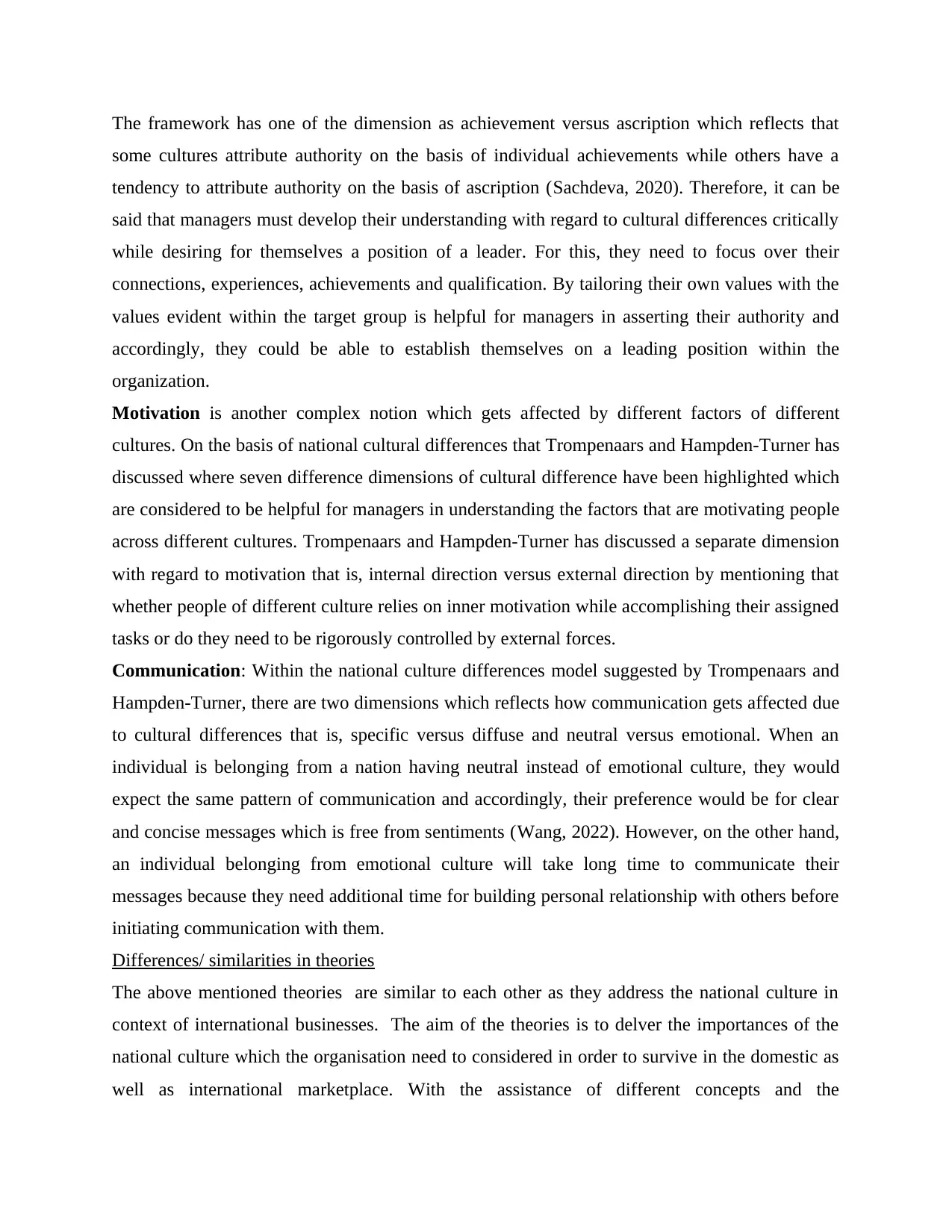
The framework has one of the dimension as achievement versus ascription which reflects that
some cultures attribute authority on the basis of individual achievements while others have a
tendency to attribute authority on the basis of ascription (Sachdeva, 2020). Therefore, it can be
said that managers must develop their understanding with regard to cultural differences critically
while desiring for themselves a position of a leader. For this, they need to focus over their
connections, experiences, achievements and qualification. By tailoring their own values with the
values evident within the target group is helpful for managers in asserting their authority and
accordingly, they could be able to establish themselves on a leading position within the
organization.
Motivation is another complex notion which gets affected by different factors of different
cultures. On the basis of national cultural differences that Trompenaars and Hampden-Turner has
discussed where seven difference dimensions of cultural difference have been highlighted which
are considered to be helpful for managers in understanding the factors that are motivating people
across different cultures. Trompenaars and Hampden-Turner has discussed a separate dimension
with regard to motivation that is, internal direction versus external direction by mentioning that
whether people of different culture relies on inner motivation while accomplishing their assigned
tasks or do they need to be rigorously controlled by external forces.
Communication: Within the national culture differences model suggested by Trompenaars and
Hampden-Turner, there are two dimensions which reflects how communication gets affected due
to cultural differences that is, specific versus diffuse and neutral versus emotional. When an
individual is belonging from a nation having neutral instead of emotional culture, they would
expect the same pattern of communication and accordingly, their preference would be for clear
and concise messages which is free from sentiments (Wang, 2022). However, on the other hand,
an individual belonging from emotional culture will take long time to communicate their
messages because they need additional time for building personal relationship with others before
initiating communication with them.
Differences/ similarities in theories
The above mentioned theories are similar to each other as they address the national culture in
context of international businesses. The aim of the theories is to delver the importances of the
national culture which the organisation need to considered in order to survive in the domestic as
well as international marketplace. With the assistance of different concepts and the
some cultures attribute authority on the basis of individual achievements while others have a
tendency to attribute authority on the basis of ascription (Sachdeva, 2020). Therefore, it can be
said that managers must develop their understanding with regard to cultural differences critically
while desiring for themselves a position of a leader. For this, they need to focus over their
connections, experiences, achievements and qualification. By tailoring their own values with the
values evident within the target group is helpful for managers in asserting their authority and
accordingly, they could be able to establish themselves on a leading position within the
organization.
Motivation is another complex notion which gets affected by different factors of different
cultures. On the basis of national cultural differences that Trompenaars and Hampden-Turner has
discussed where seven difference dimensions of cultural difference have been highlighted which
are considered to be helpful for managers in understanding the factors that are motivating people
across different cultures. Trompenaars and Hampden-Turner has discussed a separate dimension
with regard to motivation that is, internal direction versus external direction by mentioning that
whether people of different culture relies on inner motivation while accomplishing their assigned
tasks or do they need to be rigorously controlled by external forces.
Communication: Within the national culture differences model suggested by Trompenaars and
Hampden-Turner, there are two dimensions which reflects how communication gets affected due
to cultural differences that is, specific versus diffuse and neutral versus emotional. When an
individual is belonging from a nation having neutral instead of emotional culture, they would
expect the same pattern of communication and accordingly, their preference would be for clear
and concise messages which is free from sentiments (Wang, 2022). However, on the other hand,
an individual belonging from emotional culture will take long time to communicate their
messages because they need additional time for building personal relationship with others before
initiating communication with them.
Differences/ similarities in theories
The above mentioned theories are similar to each other as they address the national culture in
context of international businesses. The aim of the theories is to delver the importances of the
national culture which the organisation need to considered in order to survive in the domestic as
well as international marketplace. With the assistance of different concepts and the
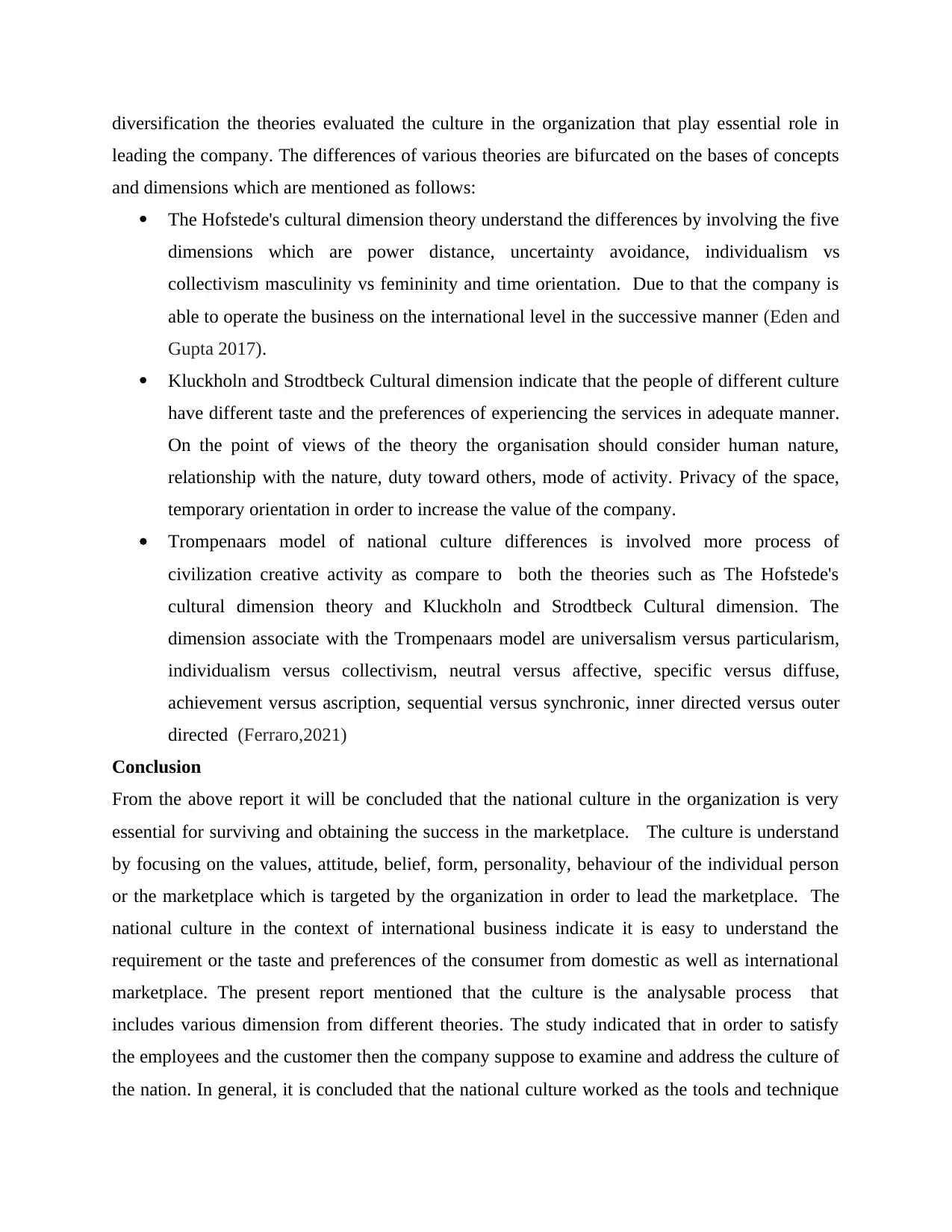
diversification the theories evaluated the culture in the organization that play essential role in
leading the company. The differences of various theories are bifurcated on the bases of concepts
and dimensions which are mentioned as follows:
The Hofstede's cultural dimension theory understand the differences by involving the five
dimensions which are power distance, uncertainty avoidance, individualism vs
collectivism masculinity vs femininity and time orientation. Due to that the company is
able to operate the business on the international level in the successive manner (Eden and
Gupta 2017).
Kluckholn and Strodtbeck Cultural dimension indicate that the people of different culture
have different taste and the preferences of experiencing the services in adequate manner.
On the point of views of the theory the organisation should consider human nature,
relationship with the nature, duty toward others, mode of activity. Privacy of the space,
temporary orientation in order to increase the value of the company.
Trompenaars model of national culture differences is involved more process of
civilization creative activity as compare to both the theories such as The Hofstede's
cultural dimension theory and Kluckholn and Strodtbeck Cultural dimension. The
dimension associate with the Trompenaars model are universalism versus particularism,
individualism versus collectivism, neutral versus affective, specific versus diffuse,
achievement versus ascription, sequential versus synchronic, inner directed versus outer
directed (Ferraro,2021)
Conclusion
From the above report it will be concluded that the national culture in the organization is very
essential for surviving and obtaining the success in the marketplace. The culture is understand
by focusing on the values, attitude, belief, form, personality, behaviour of the individual person
or the marketplace which is targeted by the organization in order to lead the marketplace. The
national culture in the context of international business indicate it is easy to understand the
requirement or the taste and preferences of the consumer from domestic as well as international
marketplace. The present report mentioned that the culture is the analysable process that
includes various dimension from different theories. The study indicated that in order to satisfy
the employees and the customer then the company suppose to examine and address the culture of
the nation. In general, it is concluded that the national culture worked as the tools and technique
leading the company. The differences of various theories are bifurcated on the bases of concepts
and dimensions which are mentioned as follows:
The Hofstede's cultural dimension theory understand the differences by involving the five
dimensions which are power distance, uncertainty avoidance, individualism vs
collectivism masculinity vs femininity and time orientation. Due to that the company is
able to operate the business on the international level in the successive manner (Eden and
Gupta 2017).
Kluckholn and Strodtbeck Cultural dimension indicate that the people of different culture
have different taste and the preferences of experiencing the services in adequate manner.
On the point of views of the theory the organisation should consider human nature,
relationship with the nature, duty toward others, mode of activity. Privacy of the space,
temporary orientation in order to increase the value of the company.
Trompenaars model of national culture differences is involved more process of
civilization creative activity as compare to both the theories such as The Hofstede's
cultural dimension theory and Kluckholn and Strodtbeck Cultural dimension. The
dimension associate with the Trompenaars model are universalism versus particularism,
individualism versus collectivism, neutral versus affective, specific versus diffuse,
achievement versus ascription, sequential versus synchronic, inner directed versus outer
directed (Ferraro,2021)
Conclusion
From the above report it will be concluded that the national culture in the organization is very
essential for surviving and obtaining the success in the marketplace. The culture is understand
by focusing on the values, attitude, belief, form, personality, behaviour of the individual person
or the marketplace which is targeted by the organization in order to lead the marketplace. The
national culture in the context of international business indicate it is easy to understand the
requirement or the taste and preferences of the consumer from domestic as well as international
marketplace. The present report mentioned that the culture is the analysable process that
includes various dimension from different theories. The study indicated that in order to satisfy
the employees and the customer then the company suppose to examine and address the culture of
the nation. In general, it is concluded that the national culture worked as the tools and technique
⊘ This is a preview!⊘
Do you want full access?
Subscribe today to unlock all pages.

Trusted by 1+ million students worldwide
1 out of 15
Related Documents
Your All-in-One AI-Powered Toolkit for Academic Success.
+13062052269
info@desklib.com
Available 24*7 on WhatsApp / Email
![[object Object]](/_next/static/media/star-bottom.7253800d.svg)
Unlock your academic potential
Copyright © 2020–2025 A2Z Services. All Rights Reserved. Developed and managed by ZUCOL.



